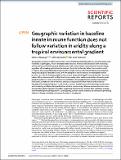Files in this item
Geographic variation in baseline innate immune function does not follow variation in aridity along a tropical environmental gradient
Item metadata
| dc.contributor.author | Nwaogu, Chima Josiah | |
| dc.contributor.author | Cresswell, Will | |
| dc.contributor.author | Tieleman, Irene | |
| dc.date.accessioned | 2020-04-09T14:30:02Z | |
| dc.date.available | 2020-04-09T14:30:02Z | |
| dc.date.issued | 2020-04-03 | |
| dc.identifier | 266933003 | |
| dc.identifier | a97f0fcb-a203-4653-a976-0b06effc7cd1 | |
| dc.identifier | 85083041074 | |
| dc.identifier | 000563492400003 | |
| dc.identifier.citation | Nwaogu , C J , Cresswell , W & Tieleman , I 2020 , ' Geographic variation in baseline innate immune function does not follow variation in aridity along a tropical environmental gradient ' , Scientific Reports , vol. 10 , 5909 . https://doi.org/10.1038/s41598-020-62806-1 | en |
| dc.identifier.issn | 2045-2322 | |
| dc.identifier.other | ORCID: /0000-0002-4684-7624/work/71954862 | |
| dc.identifier.uri | https://hdl.handle.net/10023/19773 | |
| dc.description | C.J.N. was supported by a studentship funded by the Leventis Conservation Foundation through the University of St. Andrews, UK and an Ubbo Emmius grant of the University of Groningen. B.I.T. was supported by the Netherlands Organisation for Scientific Research (NWO-Vidi 864.10.012). This is publication number 141 of the A.P. Leventis Ornithological Research Institute, Nigeria and chapter 7 of the thesis ‘Avian life in a seasonally arid tropical environment: adaptations and mechanisms in breeding, molt and immune function’91, submitted for the award of a doctorate degree by the University of Groningen, the Netherlands and University of St. Andrews, UK. | en |
| dc.description.abstract | Geographic variation in aridity determines environmental productivity patterns, including large-scale variability in pathogens, vectors and associated diseases. If disease risk decreases with increasing aridity and is matched by immune defense, we predict a decrease in innate immune function along a gradient of increasing aridity from the cool-wet forest to the hot-dry Sahel, from south to north in Nigeria. We sampled blood and measured five innate immune indices from 286 Common Bulbuls Pycnonotus barbatus between 6 and 13°N. We sampled in the dry season; we resampled the first location (Jos) also as the last sample location to test temporal change in immune function. Immune indices did not decrease with aridity. One immune index, nitric oxide concentration showed a weak quadratic pattern. In Jos, ovotransferrin concentration, haemagglutination and haemolysis titres increased 12 weeks into the dry season, contrary to expectations that immune indices should decrease with increased dryness. In this tropical system, innate immune function does not decrease with increasing aridity but temporal factors within a location may influence immune function more strongly than spatial variation in aridity, suggesting that immune variation does not follow a simple environmental productivity pattern. Consequently, caution should probably be exercised in predicting effects of climate variability on immune function or disease risk. | |
| dc.format.extent | 13 | |
| dc.format.extent | 1927825 | |
| dc.language.iso | eng | |
| dc.relation.ispartof | Scientific Reports | en |
| dc.subject | QH301 Biology | en |
| dc.subject | DAS | en |
| dc.subject.lcc | QH301 | en |
| dc.title | Geographic variation in baseline innate immune function does not follow variation in aridity along a tropical environmental gradient | en |
| dc.type | Journal article | en |
| dc.contributor.institution | University of St Andrews. School of Biology | en |
| dc.contributor.institution | University of St Andrews. Centre for Biological Diversity | en |
| dc.contributor.institution | University of St Andrews. Scottish Oceans Institute | en |
| dc.contributor.institution | University of St Andrews. Institute of Behavioural and Neural Sciences | en |
| dc.contributor.institution | University of St Andrews. St Andrews Sustainability Institute | en |
| dc.identifier.doi | 10.1038/s41598-020-62806-1 | |
| dc.description.status | Peer reviewed | en |
This item appears in the following Collection(s)
Items in the St Andrews Research Repository are protected by copyright, with all rights reserved, unless otherwise indicated.

